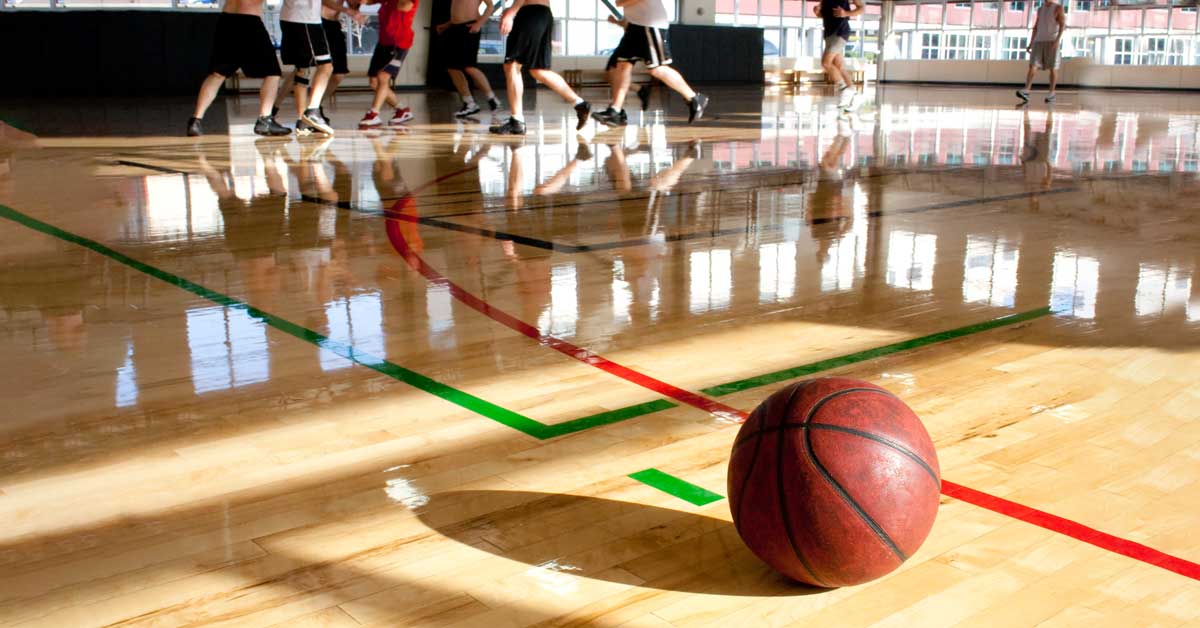Time moves in one direction. We wish we had more. We also believe that we can cram everything into these short time periods. The reality is that whether you are a coach, an athlete, or a person who works a 9-5 job, time will always be a limiting factor.
I had an aha moment during my recent podcast with legendary coach Dan Pfaff, in terms of using density patterns as a main driver in training. These frequent “hits” of training can be used as daily vitamins for athletes. I began to brainstorm ways in which I can pilot this approach into my own specific situation. The article that follows will hopefully outline my thought process and ways to implement the micro sessions into a physical preparation program.
My Situation
I am lucky enough to teach at a K-12 school where I also have the opportunity to coach athletic teams:
- Middle school (grades 6-8, ages 11-13)
- Track & field
- Golf
- Girls’ basketball
- Girls’ soccer
- High School (grades 9-12, ages 14-18)
- Boys’ basketball
- Boys’ lacrosse
With that being said, there are challenges when it comes to training student-athletes. I work at a smaller school that relies on multisport participation to field full teams. This makes for limited opportunities to expose athletes to consistent training, whether it is on-field work or in the fitness center. The emergence of club sports and non-school-related athletic programs has also muddied the waters.
Time is a major variable…and being concise is important. So, I had to ask myself, ‘how can I trim the fat off my training program to tick off the most boxes for athletes?’ Share on XTime is a major variable for me as a coach. I always wish I had more. I also have to take into account the athletes’ time. In today’s climate, life is lived in 280 characters. Being concise is important. So, the question I had to ask myself was, “how can I trim the fat off my training program to tick off the most boxes for my athletes?”
It took some time to fully accept that there will be trade-offs and that it wouldn’t be the perfect training program according to the textbooks. But I have to live in reality here.
How It Came Together
After talking with Dan Pfaff, I started thinking about how manipulating training density patterns could fit into a developing athlete’s preparation. The concept of microdosing that has made its way into the physical preparation profession immediately came to mind. For those new to the microdosing concept, I’m not talking pharmacological intervention—I am simply using the general idea as a framework to plan athlete training. Derek Hansen has written extensively on the topic for those seeking clarification or a more detailed description.
Dan John’s “one lift a day” program completely eliminates fluff and forces you to really think about what’s important to accomplish for that day. That simplicity struck me. Share on XAround the same time, I was preparing for an upcoming podcast with Coach Dan John. Dan is an avid writer and is well-known for his book Easy Strength. I was reading some of Dan’s work and I stumbled across one of his articles, “The One Lift a Day Program.” In it, he basically lays out that you pick one movement for that day and do it. It completely eliminates any fluff and forces you to really think about what’s important to accomplish for that day.
That simplicity struck me. There was no sense chasing my tail trying to fit all these pieces into my daily sessions. It was time to reevaluate my program (and my ego).
Where to Start?
As an assistant sport coach and lead strength coach, most of my training window falls within school and after-school athletic hours. There were two major time periods where I could insert this approach daily. The first was prior to school. This works particularly well for older varsity athletes who can drive themselves to school. The second was immediately after school or as a part of an extended warm-up before sport practice. We have the middle-schoolers during the final period of the school day, and I see my high school athletes immediately following the end of the school day.
An example of a typical daily training window is:

The most time I have on any given day is around 30 minutes. The low end would be 15 minutes. The next question is what are the essential KPIs that we want to improve? With that information and a general needs analysis, I could start thinking about how training would look.

One important piece of the puzzle reveals itself once you’ve reverse-engineered back from the target date. Your KPIs will fluctuate quite a bit if you only have six weeks with an athlete versus, say, four years. An example is if you had six weeks to make someone a better basketball player, then the bulk of your time should probably be spent on the game itself. In my case, I had to respect both the short and long term. I can slow cook development while also picking my spots to push the envelope a bit.
Two models that I’ve found useful in determining where to direct your training are Dan Pfaff’s generational framework and Dr. Bondarchuk’s exercise classifications. They both seem to get at what the differentiation between general and specific training means. In Dan’s model, the first-generation items are closely related to the sporting actions. The second generation gets less specific. The third, fourth, etc. generation menu items are basically general training means by their nature. Bondarchuk’s model provides a similar representation.
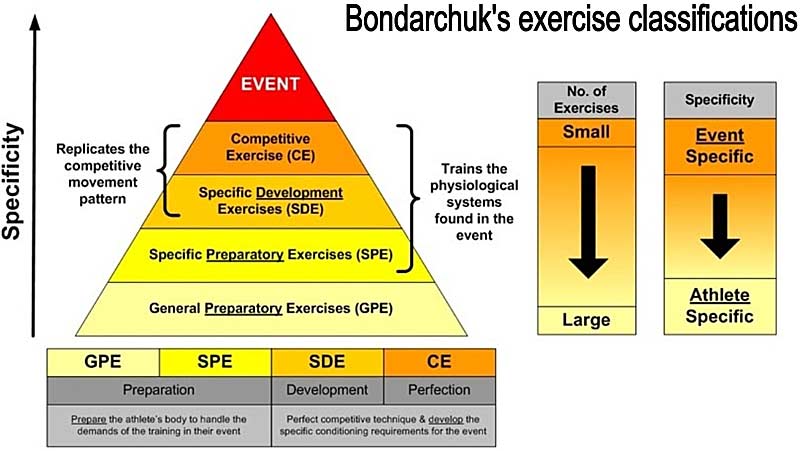
What Does It Look Like?
Once I figured out some of the training ergonomics, it was time to start determining how the program would look. Below are two examples—one lifting and the other running-based—of how I planned out these micro sessions. The first is during an off-season period. The second is during a pre-season period.
The training menu that I usually pick from contains the following main categories:
- Sprint training
- Tempo running
- Jumps/plyometrics
- Strength training
- Medicine ball training
The exercises/movements I choose will have to fit my athletes and their needs. Based on those categories, what do I believe will give them the most bang for their buck? It’s difficult at first to only choose one to two things. Mapping out a cost-benefit analysis helped ease any second guessing and kept me seeing things in a more objective light.
The amount of time I have during each daily session will dictate my options for training. This program relies heavily on consistency of training. Below is a diagram that outlines how training could be allocated based on time constraints.
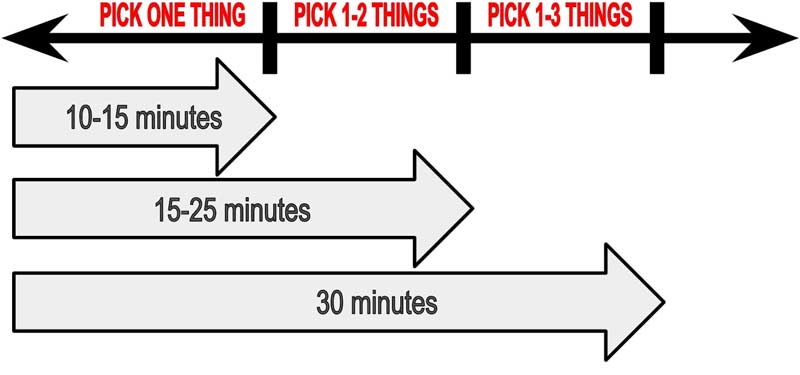
Off-Season, Boys Basketball – General Strength
Here is an example of a 20-minute after-school strength training segment for grade 9-12 varsity boys’ basketball players. The goal during this period is to raise general work capacity in our main lifts. An easy way to do that is to add a set each week. These sessions served as a main stimulus for some students, and for those playing other sports or pick-up games it acted as an extended warm-up and/or maintenance.
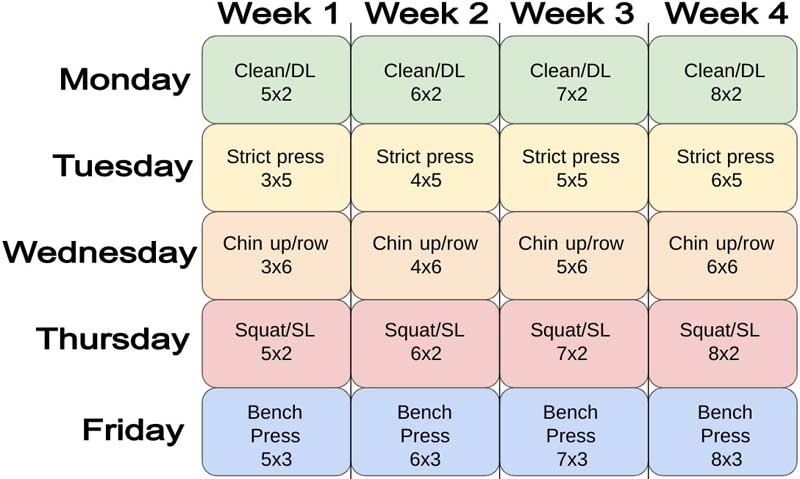
As coaches, we can play with set/rep schemes in order to accommodate different athletes. If I have a large group without enough equipment, I’ll have some athletes start with different movements so that our rotations are staggered. Instead of doing movement A on Monday, for example, movement A will be a Thursday choice for some athletes.
When doing a program that is highly dependent on time, I found that keeping a running clock was the best way to keep things on schedule. For example, if we are doing 8×2 on the squat, I set a countdown from eight minutes, and the athlete will do a set EMOM (every minute on the minute) style. If there are two athletes working, set the clock to 8:30. One starts on the minute (00:00, 01:00, 02:00, etc.) and the other starts at the 30-second mark (00:30, 1:30, 2:30, etc.).
Video 1. Sped-up version of EMOM “daily vitamin” lift.
Exercise choices can be switched once we get through the fourth week. Examples of some transitions are deadlift to clean variation, strict press to push press, inverted row to chin-up, split squat to front squat, and bench press to incline press. Again, the goal is simplicity and compliance. The sets and reps may look low and in favor of max strength, but that’s not entirely the case.
I believe strength is a skill. Each set should work toward “greasing the groove.” We should never miss a training rep. On some days we can push the gas and work up above 85% 1RM, while on others we will drop the weight well below submaximal and add in a slow rep cadence for recovery. That’s what makes coaching a science and an art.
If I have an injured athlete or a first-year lifter, I move to plan B. However, I need to make plan B as close to plan A as possible, so I can still give the athlete something to adapt to—the flexibility of this type of program is another benefit.
One caveat is the possibility of soreness when you are doing one lift a day and that lift once per week. It’s important to progress the volume, intensity, and exercise choice appropriately. Share on XOne caveat I want to point out is the possibility of soreness when you are doing one lift a day and that lift once per week. It’s important to progress the volume, intensity, and exercise choice appropriately. Again, each training session should be in service to your major KPIs and the needs of your population.
Pre-Season, Girls Soccer – Acceleration Training
Here is an example of a 25-minute acceleration training segment during the pre-season period for some middle school and varsity girls’ soccer players.
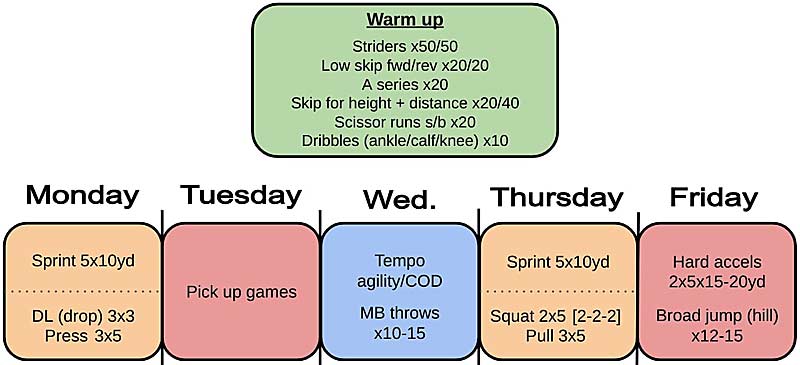
The weekly template is planned to follow a high-low intensity scheme. The orange blocks would be considered a medium intensity. The red blocks are high intensity. The blue block acts as a low-intensity, active recovery session.
We are still following the “daily vitamin” approach during the weekly sessions, only the dosages will vary to allow the athletes to recover and adapt. To reiterate, daily vitamins in this context is an allegory that describes using small, frequent training sessions on a consistent basis. A daily vitamin is as easy as waking up, getting it, and taking it. It’s simple and easy, and the same idea applies with training sessions. You get in and you get out.
To reiterate, ‘daily vitamins’ in this context is an allegory that describes using small, frequent training sessions on a consistent basis. Share on XStarting on Monday, the team will go through their on-field warm-up. The end of the warm-up period is when we dose in some short accelerations. The girls follow the field work with a brief strength training session. Deadlifts are done with moderate loads (80%-85% 1RM) and athletes drop the bar at the top of each rep. The press can be either horizontal or vertical. The weight will be moderate, and the focus will be on smooth, quality reps.
Tuesday is player-led pick-up games. This day is treated as a “high” intensity day.
Coming off playing on Tuesday, Wednesday is a tempo-based recovery day. Based on how the girls feel, the session will be a mix of linear and multidirectional drills. Each drill is done below 75% effort, and the focus is on movement efficiency and exposing their tissues to a variety of planes, postures, etc. Most of the movement sessions will be time-based. The total yardage is kept fairly low, between 750 and 1,200 meters, compared to a traditional off-season tempo run sessionfor a soccer player (3,000-4,000 meters).
Wednesday’s session ends with medicine ball throws. The typical menu items for throws include:
- Overhead backward throw.
- Broad jump forward throw.
- Between legs forward throw.
- Overhead step/throw.
- Rotational low to high throw.
Thursday is a similar session to Tuesday. The only difference is we use a squat variation with a lighter weight and a slow, controlled rep cadence. During these recovery squats, I like to have athletes go pretty deep so that the hamstring and calf meet.
A progression I like to use is from Coach Alan Bishop. I have athletes start with an elevated heel front squat and slowly progress to a feet flat back squat. Alan’s article outlines the full progression. The girls also perform a vertical or horizontal pull exercise. My go-tos are any chin-up or inverted row variations. If we chose a horizontal row, I might bump the reps up to 8-10 in order to build some volume and balance out the back musculature.
Video 2. Part of a “daily vitamin” squat progression.
Friday is our gas pedal session. We do hard accelerations out to 20 yards. Rest periods between sprints range from 60-120 seconds. After the first set of five sprints, the girls have a five-minute break to act as a buffer. After the break, we complete the second set of sprints. Our high-intensity acceleration day finishes up with some standing broad jumps up a hill. I typically start out with single jumps, then progress to doubles and triples once they look smooth.
Each session is subject to change based on countless factors. The training sets, reps, and volumes will fluctuate, but the graphic displays a solid general template. Based on your situation, you can expand or condense this template to fit your program’s schedule.
Practical Applications
Spots where these “daily vitamin” training sessions can fit into your program:
- The warm-up.
- During sport practice.
- During training sessions.
- During the summer or periods where you are away from athletes.
The warm-up is a perfect time to plug in some extra work. Whether it’s adding in movements that act as a screen or having athletes perform accelerations, the warm-up is an underutilized piece of a session. With more research focusing on soft tissue injury, many elite coaches are using top speed running to act as a type of “vaccination” to hamstring injuries. What this means is that athletes perform a baseline number of max velocity efforts that, in turn, expose their tissues to those high velocities and contractions.
Whether it’s adding in movements that act as a screen or having athletes perform accelerations, the warm-up is an underutilized piece of a session. Share on XIn talking with Dan Pfaff, he found having athletes perform five runs out to 40-50 yards at top speed once a week was enough of an exposure to keep them fit throughout the season. Dan has also collected data from many European sport athletes that suggests three to four accelerations out to 20-30 yards, three to four times a week was enough to maintain that sprinting quality.
Both accelerations and top speed runs can be done at the tail end of the warm-up, prior to practice. Another alternate warm-up method is to use the weight room as a bridge to sport practice. I remember listening to NBA strength coach Cory Schlesinger talk about how he had athletes come in and do a mini training session before practice. These mini sessions substituted for their traditional warm-up. In doing this, Cory not only got their strength/power work in, but he also broke up the staleness that comes along with doing the same warm-up day in and day out.
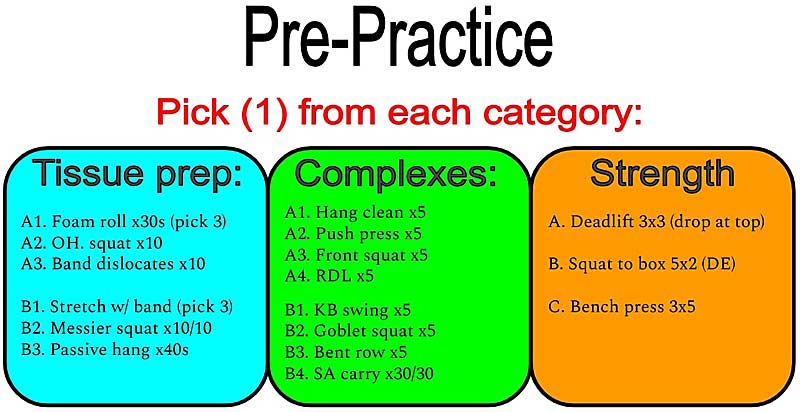
Another opportunity to microdose certain qualities is during the sport practice itself. From a purely training perspective, exposure to max velocity is a great example of this. Like Dan Pfaff said, if you have high intent and accountability, you can ask athletes to sprint out a few reps in practice to get those max velocity exposures. These longer top speed runs should be done during the first part of practice so that the athletes are fresher.
If you are lucky enough to be a sport coach, you can plan drills that will incorporate specific training targets within practice. Soccer coach Raymond Verheijen does a wonderful job laying out his principles of “football fitness.” Raymond uses the game itself to help athletes gain specific fitness. Raymond begins playing 11v11 for a set timeframe to start developing work capacity. He will use, say, a 3v3 to intensify practice and work on higher, more frequent outputs.
A perk of giving your athletes these daily vitamins is that they are easy to understand and are brief enough to hold the athletes accountable. One to two movements a day can build consistency and habits that can roll over into other aspects in life. It can also improve focus during sessions. If I only have one lift of seven sets today, I need to really focus in order to get the most out of my workout.
One to two movements a day can build consistency and habits that can roll over into other aspects in life. It can also improve focus during sessions. Share on XIf you lose your athletes during the summer or breaks, giving them one movement a day can open the door for them to film their sessions and send it to you for feedback. Again, they have to meet you halfway and make an effort. I am lucky enough to work with some students who are gym rats. I give them the one or two movements I think will help them the most and then they can go do whatever else they want. You want to do the “German Volume Arm Blaster 5000”? Go right ahead but do your sprints and squats first.
Less but Better
I try to read and consume as much information on training and the human body as possible. That has led to me trying to jam way too much into my programs. My aim was to make my athletes masters of everything. The reality was that we became masters of none.
There is a phrase in the book Essentialism that I have taped on my office wall. It reads: Less but better. Instead of trying to stuff 10 pounds of crap into a 5-pound bag, I had to identify the glaring gaps and try to fill them as best I could. For some, it is running based; for others, it could be a weight room intervention. In my limited experience, the two major limiting factors for athletes have been:
- How they play their sport.
- Their mental/psychological fitness.
All training goes to the wayside if they aren’t competent performers and if they don’t have the toolbox to navigate mental/emotional landmines.
If you’re looking for a switch up or you feel like you are getting lost in the granular details, try this approach. If the daily vitamins don’t work, then move on down the road. Like Bruce Lee said, “absorb what is useful, reject what is useless, add what is essentially your own.”
Since you’re here…
…we have a small favor to ask. More people are reading SimpliFaster than ever, and each week we bring you compelling content from coaches, sport scientists, and physiotherapists who are devoted to building better athletes. Please take a moment to share the articles on social media, engage the authors with questions and comments below, and link to articles when appropriate if you have a blog or participate on forums of related topics. — SF

